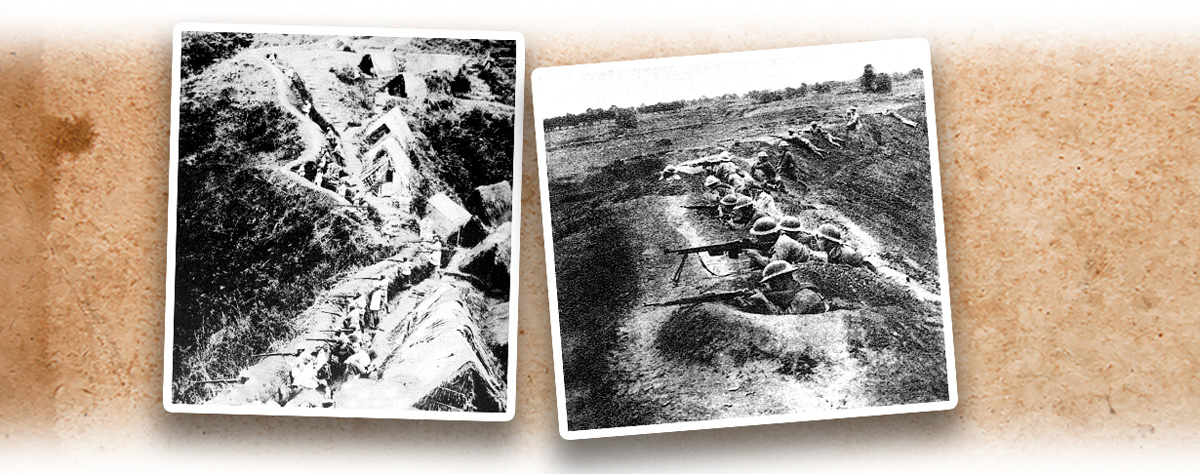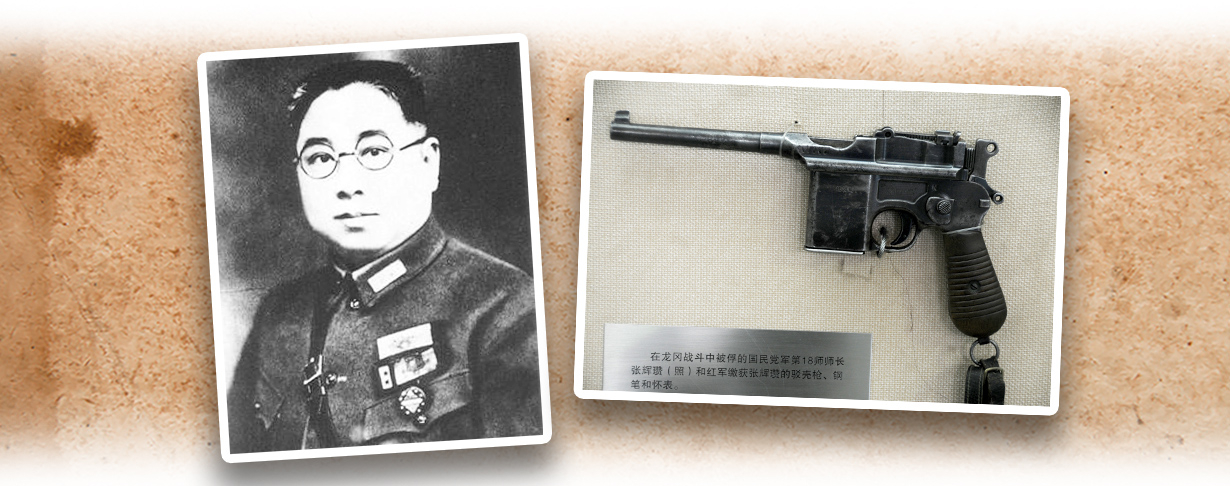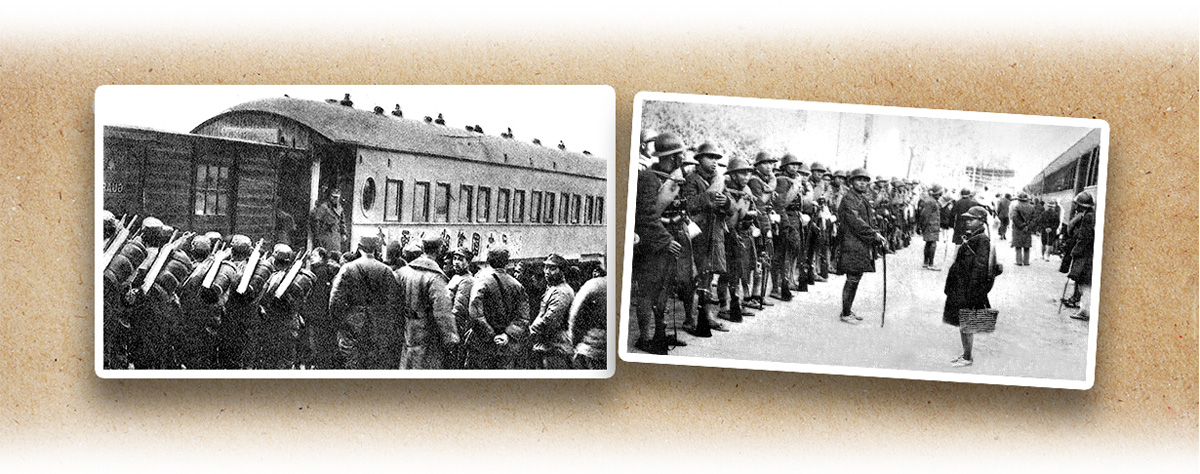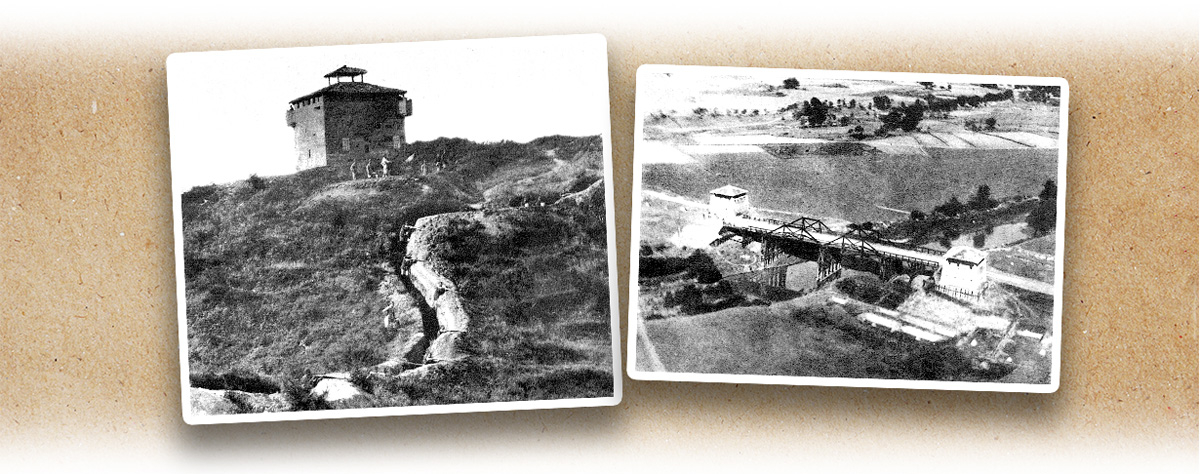1927-37 was a decade of armed confrontations between the Kuomintang of China (KMT, 中國國民黨) and the Chinese Communist Party (CCP, 中國共產黨). As the CCP’s armed separatist regime seriously threatened the Nationalist Government, Chiang Kai-shek (蔣介石) went all out to besiege the Red Army after winning the Central Plains War. The Japanese invasion of China was imminent at that time, but Chiang accented in a public letter in July 1931 rallying the whole country to “first annihilate the bandits, then the Japanese; first internal pacification, then external resistance”. Since the end of 1930, five campaigns of encirclement and extermination were launched against the CCP’s base in Jiangxi Province (江西):
(1) From December 1930 to January 1931, Chiang mobilised 100,000 troops to besiege. The Red Army lured the KMT’s army deep into its base and crushed the enemy.
(2) From April to May 1931, the KMT deployed 200,000 troops to besiege but failed.
(3) From July to September 1931, while dispatching 300,000 troops to besiege, Chiang also assumed the role of commander-in-chief and rushed to Nanchang (南昌) to command. Meanwhile, German, Japanese, and British military advisers were invited to participate in war planning. On the CCP side, Mao Zedong (毛澤東) commanded more than 30,000 soldiers of the First Front Army to avoid confronting the enemy’s main force while wiping out its seven divisions.
(4) From December 1932 to March 1933, the KMT mustered 500,000 troops to launch the fourth campaign. Chiang went to Nanchang again to acted as commander-in-chief of the army of bandit suppression in the border regions of Jiangxi, Guangdong (廣東), and Fujian (福建), but was defeated by the Red Army.
(5) From September 1933 to October 1934, a million KMT soldiers launched the fifth campaign by employing the “blockhouse tactic”. The Red Army, however, was left with only around 110,000 soldiers. In addition, together with the wrong military commands made by Otto Braun, the German military adviser of the Communist International (Comintern), Bo Gu (博古), a leader of the CCP Central Committee, and others made wrong military commands. All these finally forced the Red Army’s evacuation of the Central Soviet Zone and the commencement of the Long March.
|
|
Why did the CCP Red Army overcame the first four campaigns of encirclement and extermination by the KMT but was crushed in the fifth? |
|
|
See answer below. |
The Jiangxi Red Army in the 1930s. As the CCP Red Army continued to grow in Jiangxi, the Nanjing (南京) Nationalist Government was ready to go all out to eliminate it. As a result, fierce battles of encirclement and counterattack broke out between the KMT’s National Revolutionary Army (NRA) and the CCP’s Red Army.
From December 1930 to January 1931, Chiang Kai-shek sent 100,000 KMT troops to encircle and exterminate the CCP’s base in Jiangxi but were defeated. Zhang Huizan (張輝瓚), the commander of the 18th Division of the NRA, was captured and beheaded. The photo shows Zhang and his gun.
After the first attempt failed, Chiang Kai-shek mobilised more troops to exterminate the CCP. There were 200,000, 300,000, and 500,000 troops participating in the second, third, and fourth attempts respectively. In addition to sending his own elite, the Whampoa Direct Descendent, Chiang also recruited a large number of troops from other places to fight. The photos show the NRA soldiers assembled at different railway stations to prepare for eliminating the CCP in Jiangxi.
The KMT Central Army at the encirclement and extermination of the Jiangxi Red Army. The combat effectiveness of the Central Army was stronger than that of other regional armies.
Chiang Kai-shek once dispatched his air force to participate in the encirclement and extermination of the Jiangxi Red Army in the 1930s.
By adopting guerrilla warfare, the Red Army crushed four large-scale encirclements. Apart from counterattacking, the CCP also stepped up its propaganda campaign. Left: a propaganda poster of the Red Army capturing the enemy’s commander of division alive in 1931. Middle: in 1931, the CCP’s Red Flag Daily (《紅旗日報》) reported the Red Army’s victory in its counterattack campaign. Right: propaganda materials for the fourth counterattack campaign in 1931.
In the first four counterattack battles, the Red Army adopted guerrilla tactics against the NRA. By employing the principle of “when the enemy advances, we retreat; when the enemy camps, we harass; when the enemy tires, we attack; when the enemy retreats, we pursue”, the Red Army made full use of its familiarity with the terrain and lured the enemy into its base. Without much confrontation, the Red Army continued to harass the enemy when it camped and waited for the opportunity to attack its vulnerabilities by going all out to besiege and annihilate. The small victories in multiple wipe-outs of small groups of enemies led to final triumph and ultimately disintegrated the NRA’s offensive.
From left: Wang Ming (王明), Bo Gu, and Otto Braun. Chiang Kai-shek (last photo, first from right in the front row) inspecting the officers and soldiers of the suppression campaign in May 1933. After the end of the fourth attempt in March 1933, Chiang began to deploy the fifth one. The CCP’s revolutionary route was led by Wang, a CCP Central Committee leader cultivated by the Soviet Union. The CCP Central Government in Ruijin (瑞金) was controlled by Bo Gu, while Otto Braun, the German military adviser, determined the Red Army’s counterattack.
After four failed attempts, Chiang Kai-shek decided to throw in an unprecedented scale of a million troops to the fifth attempt in September 1933. By abandoning the previous tactics of advancing on the enemy’s bases and fell into its traps easily, he adopted the “blockhouse tactic” on the Red Army. The photos show the NRA building blockhouses.
In the fifth campaign, the blockhouses built by the NRA were robust, interconnected, and closely linked. The Red Army was disadvantaged as it lacked heavy artillery to destroy the blockhouses.
It is generally believed that the “blockhouses tactic” in the fifth encirclement and extermination was devised by the German advisers: to build heavily armed blockhouses surrounding the CCP Jiangxi Soviet Zone. Roads and even bridges were built to connect blockhouses for communication, forming an unbreakable encirclement net that completely isolated the Soviet Zone. No supplies and personnel could enter or leave the zone. While the Red Army lacked heavy artillery to break the blockade, the NRA could use the blockhouses to consolidate the defence line and advance gradually. The more blockhouse the NRA built when they propelled, the tighter the encirclement net became. Without sticking to its familiar guerrilla tactic, the Red Army led by Bo Gu, Otto Braun, and others met the enemy head on in the blockhouse warfare, resulting in heavy casualties.
Many of the Red Army soldiers captured in the fifth campaign were very young. As time stretched and the encirclement tightened, supplies became scarce, casualties and number of captives increased, and the living space shrank. There was a high chance that the Red Army could be annihilated. In the face of life and death, the CCP desperately needed to find another way out.
|
|
Why did the CCP Red Army overcame the first four campaigns of encirclement and extermination by the KMT but was crushed in the fifth? |
|
|
In the first four campaigns of encirclement and extermination, the Red Army was under the correct leadership of Mao Zedong, Zhu De, and others. They led the campaign to “fight the landed tyrants and share the land” that won peasants’ support in the base areas, while adopting the tactic “when the enemy advances, we retreat; when the enemy camps, we harass; when the enemy tires, we attack; when the enemy retreats, we pursue”. The guerrilla warfare could often lure the enemy deep into the Red Army’s base and wipe it out. However, the subsequent moving of the CCP Central Committee to the Soviet zone changed the scene. The prevailing “leftist” ideology of Wang Ming and Bo Gu had led to Mao Zedong’s dismissal for holding a “rightist” thinking. In terms of military strategies, the counterattack was commanded by Otto Braun (German military adviser of the Comintern) and Bo (Head of the CCP Central Committee), who were ill-informed of the actual situation on the Jiangxi battlefields. Instead of sticking with the familiar guerrilla tactic, the leaders employed the “standard” strategy in positional warfare, which put the Red Army in a passive and precarious position and the danger of annihilation. This forced the evacuation of the CCP leading authority and the main force of the Jiangxi and Fujian Red Army of the Central Soviet Zone and the commencement of a long march full of uncertainties. |
Sources of most photos used in this feature piece: Fotoe and misc. photo sources.















